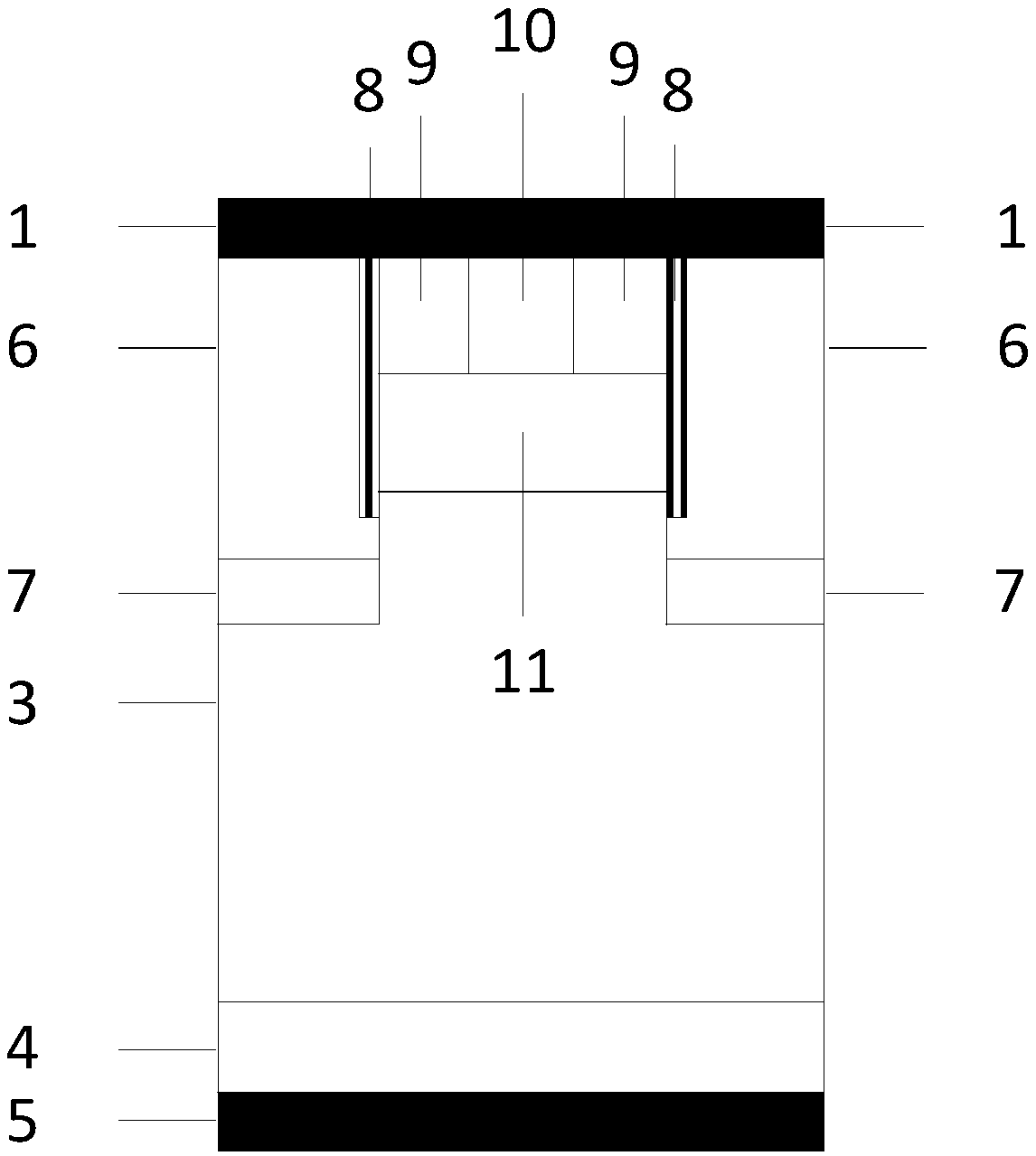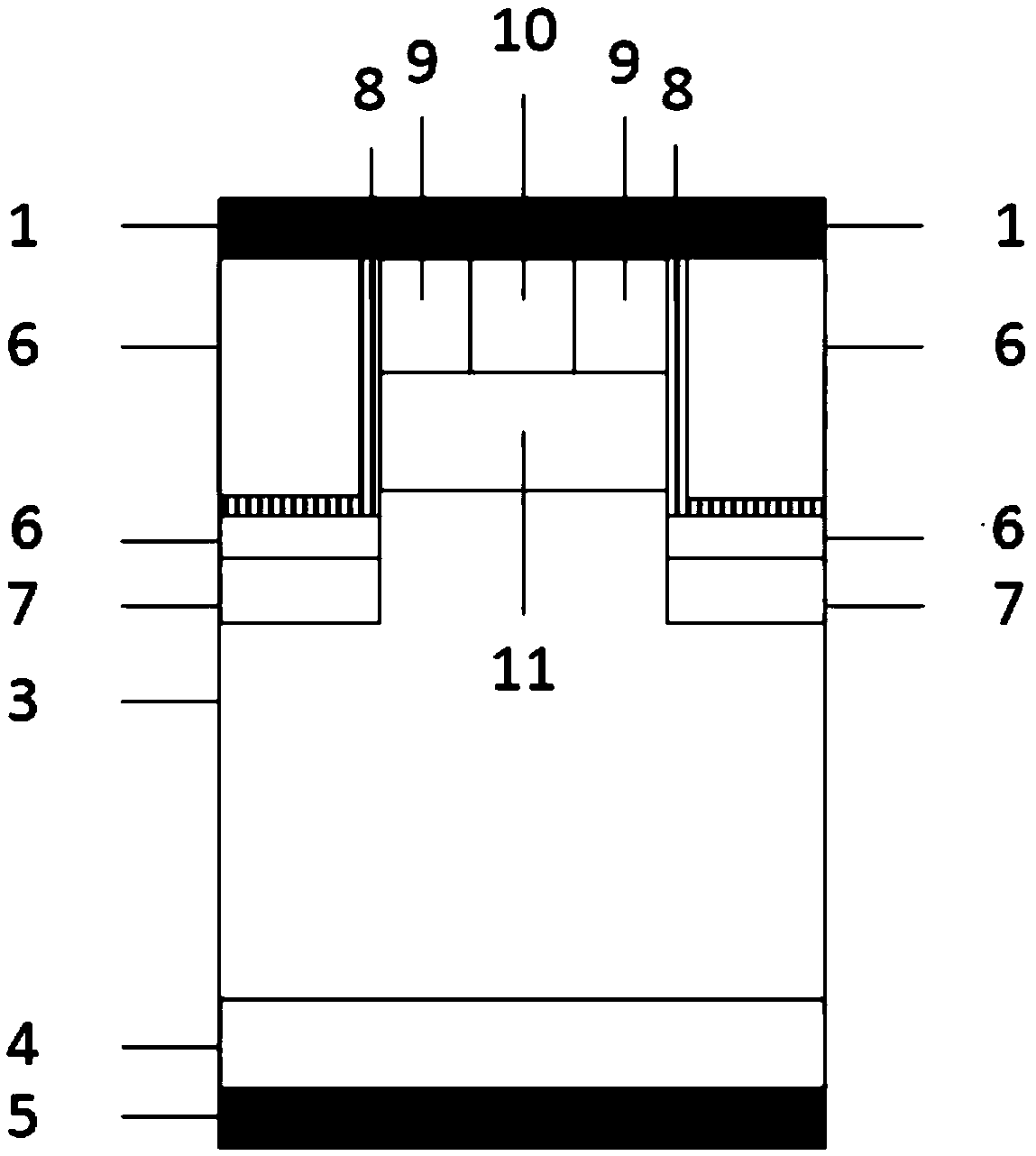Diode and manufacturing method thereof
A diode and metal anode technology, which is applied in the field of power semiconductor devices, can solve the problems of large conduction loss and poor reverse recovery characteristics, and achieve the effect of reducing the reverse recovery charge Qrr and optimizing the reverse recovery characteristics
- Summary
- Abstract
- Description
- Claims
- Application Information
AI Technical Summary
Problems solved by technology
Method used
Image
Examples
Embodiment 1
[0074] A diode device whose cell structure is as figure 2As shown, it includes metal cathode 5, N+ silicon carbide substrate 4, N- silicon carbide epitaxial layer 3 and metal anode 1 stacked in sequence from bottom to top; both sides of the top layer of N- silicon carbide epitaxial layer 3 have trench structures , the trench structure includes a P+ silicon carbide region 7 at the bottom of the trench and a polysilicon 6 at the top of the trench, the P+ silicon carbide region 7 is in direct contact with the polysilicon 6; the top layer of the N-silicon carbide epitaxial layer 3 is two There is also a P-type silicon carbide body region 11 between the trench structures on the side. The source region 9 is characterized in that: the N+ silicon carbide source region 9, the P-type silicon carbide body region 11 and part of the N- silicon carbide epitaxial layer 3 are in contact with the polysilicon 6 through the dielectric layer 8 on the side wall of the trench; the polysilicon 6 ,...
Embodiment 2
[0084] The schematic diagram of the cell structure of the diode device provided in this embodiment is as follows: image 3 As shown, the difference compared with Embodiment 1 is that the bottom end of the dielectric layer 8 extends laterally to separate the polysilicon 6 into two independent parts, and the polysilicon 6 under the dielectric layer 8 is short-circuited with the metal anode 1. The method keeps the potential of the polysilicon 6 consistent with the potential of the metal anode 1 at all times, avoiding the fluctuation of the I-V characteristic of the super-barrier structure caused by the potential change of the polysilicon 6 after the heterojunction is turned on. Compared with Embodiment 1, this embodiment improves the reliability of the device in practical applications.
Embodiment 3
[0086] The schematic diagram of the cell structure of the diode device provided in this embodiment is as follows: Figure 4 As shown, the difference compared with Embodiment 2 is that the lateral width of the P+ silicon carbide region 7 is made larger. Compared with Embodiment 2, the larger the lateral width of the P+ silicon carbide region 7 is, when the device is in the blocking state, the stronger the electric field shielding effect of the region above the P+ silicon carbide region 7 is. Structures such as heterojunction and super barrier structure also improve the withstand voltage performance of the device. It should be noted that the wider the width of the P+ silicon carbide region 7 is, the greater the on-resistance of the device works in the forward direction. Therefore, the width of the P+ silicon carbide region 7 needs to be balanced between forward and reverse operation.
[0087] In this embodiment, an N-channel diode device is taken as an example, and the width o...
PUM
 Login to View More
Login to View More Abstract
Description
Claims
Application Information
 Login to View More
Login to View More - R&D
- Intellectual Property
- Life Sciences
- Materials
- Tech Scout
- Unparalleled Data Quality
- Higher Quality Content
- 60% Fewer Hallucinations
Browse by: Latest US Patents, China's latest patents, Technical Efficacy Thesaurus, Application Domain, Technology Topic, Popular Technical Reports.
© 2025 PatSnap. All rights reserved.Legal|Privacy policy|Modern Slavery Act Transparency Statement|Sitemap|About US| Contact US: help@patsnap.com



